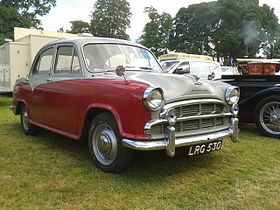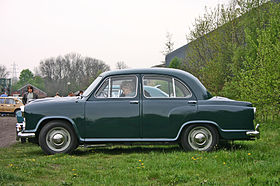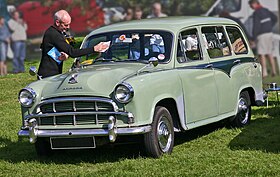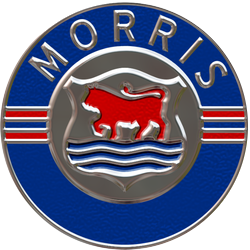
Morris Motors Limited was a British privately owned motor vehicle manufacturing company formed in 1919 to take over the assets of William Morris's WRM Motors Limited and continue production of the same vehicles. By 1926 its production represented 42 per cent of British car manufacture—a remarkable expansion rate attributed to William Morris's practice of buying in major as well as minor components and assembling them in his own factory.
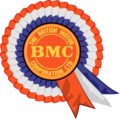
The British Motor Corporation Limited (BMC) was a UK-based vehicle manufacturer formed in early 1952 to give effect to an agreed merger of the Morris and Austin businesses.

The Austin Motor Company Limited was a British manufacturer of motor vehicles, founded in 1905 by Herbert Austin in Longbridge. In 1952 it was merged with Morris Motors Limited in the new holding company British Motor Corporation (BMC) Limited, keeping its separate identity. The marque Austin was used until 1987 by BMC's successors British Leyland and Rover Group. The trademark is currently owned by the Chinese firm SAIC Motor, after being transferred from bankrupt subsidiary Nanjing Automotive which had acquired it with MG Rover Group in July 2005.
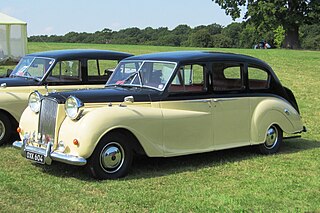
The Austin Princess is a series of large luxury cars that were made by Austin and its subsidiary Vanden Plas from 1947 to 1968. The cars were also marketed under the Princess and Vanden Plas marque names.

The Hindustan Ambassador is an automobile that was manufactured by Indian manufacturer Hindustan Motors from 1957 to 2014, with improvements and changes over its production lifetime. The Ambassador was based on the Morris Oxford series III model, first made by Morris Motors Limited at Cowley, Oxford in the United Kingdom from 1956 to 1959.

The Morris Minor is an economy car produced by British marque Morris Motors between 1948 and 1971. It made its debut at the Earls Court Motor Show, London, in October 1948. Designed under the leadership of Alec Issigonis, more than 1.6 million were manufactured in three series: the Series MM, the Series II, and the 1000 series.
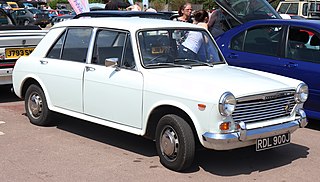
The BMC ADO16 is a range of small family cars built by the British Motor Corporation (BMC) and, later, British Leyland. Launched in 1962, it was Britain's best-selling car from 1963 to 1966 and from 1968 to 1971. The ADO16 was marketed under various make and model names; however, the Austin 1100 and Morris 1100 were the most prolific of all the ADO16 variants. The car's ubiquity at the height of its popularity led to it simply being known as the 1100 (eleven-hundred) in its home market. Also made with a 1275cc engine, it was then typically called 1300.

The BMC B series is a line of straight-4 & straight-6 internal combustion engine mostly used in motor cars, created by British automotive manufacturer Austin Motor Company.

The Riley One-Point-Five and similar Wolseley 1500 are cars produced by Riley and Wolseley respectively from 1957 until 1965. They utilised the Morris Minor floorpan, suspension and steering but were fitted with the larger 1,489 cc (90.9 cu in) B-Series engine and MG Magnette gearbox.

The Riley 4 / Sixty Eight and Riley 4 / Seventy Two are cars produced by BMC from 1959 to 1969, under the Riley marque. They are closely related to the Pinin Farina-designed MG Magnette Mark III and Wolseley 15/60 and the simpler Austin A55 Cambridge Mark II, Morris Oxford V pair, sharing the MG's rear styling and engine. This Riley was the most expensive car in that series.

The Austin A40 Farina is a small, economy car introduced by Austin in saloon (1958) and A40 Countryman (1959) estate versions. It has a two-box body configuration. It was badged, like many before it, as an A40, consistent with Austin's naming scheme at the time, based on the approximate engine output in horsepower; and to distinguish it from other A40 models, it was also given a suffix name – this one being the Farina, reflecting the all-new design by Italian Battista Farina's Pinin Farina Turin studio.

The Austin Cambridge is a medium-sized motor car range produced by the Austin Motor Company, in several generations, from September 1954 through to 1971 as cars and to 1973 as light commercials. It replaced the A40 Somerset and was entirely new, with modern unibody construction. The range had two basic body styles with the A40, A50, and early A55 using a traditional rounded shape and later A55 Mark IIs and A60s using Pininfarina styling.

The MG Magnette is a car that was produced by MG between 1953 and 1968. The Magnette was manufactured in two build series, the ZA and ZB of 1953 through to 1958 and the Mark III and Mark IV of 1959 through to 1968, both using a modified Wolseley body and an Austin engine.

The Wolseley 15/60 is an automobile which was produced from 1958 to 1961, and then, as the Wolseley 16/60, from 1961 to 1971. The 15/60 was the first of the mid-sized Pinin Farina-styled automobiles manufactured by the British Motor Corporation (BMC). Launched in December 1958 as part of BMC's Wolseley brand, the design would eventually be shared with seven other marques. All of the cars were updated in 1961 with a larger engine and new model designations. The Wolseley 16/60 was the last, in production until 24 April 1971.

The Austin Westminster series are large saloon and estate cars that were sold by the British manufacturer Austin from 1954, replacing the A70 Hereford. The Westminster line was produced as the A90, A95, A99, A105, and A110 until 1968 when the new Austin 3-Litre took its place. Essentially badge-engineered versions of the Farina Westminsters were also produced using the premium Wolseley and Vanden Plas marques. 101,634 Westminsters were built.

Morris Oxford is a series of motor car models produced by Morris of the United Kingdom, from the 1913 'bullnose' Oxford to the Farina Oxfords V and VI.
The Morris Isis name was first briefly used by Morris Motors Limited on a 6-cylinder car made from 1929 until 1931. It was resurrected on a new 6-cylinder midsize car from the British Motor Corporation in the 1950s to replace the Morris Six MS.

Morris Oxford Series MO is a car produced by Morris Motors of the United Kingdom from 1948 to 1954. It was one of several models to carry the Morris Oxford name between 1913 and 1971.

The Morris Oxford Farina is a series of motor car models that were produced by Morris of the United Kingdom from 1959 to 1971. The Farina name coming from the Italian design studio employed for styling.

Morris Oxford is a series of motor car models produced by Morris Motors of the United Kingdom, from the 1913 bullnose Oxford to the Farina Oxfords V and VI.
